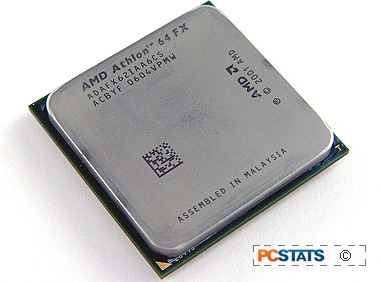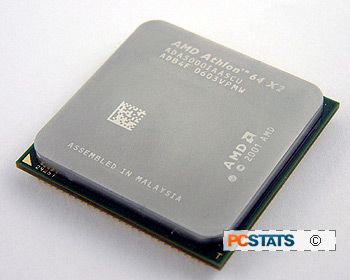 The new socket AM2 Athlon64 FX-62 and X2
5000+ processors are both manufactured in AMD's Fab 30 wafer fabrication
facility in
Dresden, Germany. The fab uses a 90 nanometer Silicon on Insulator manufacturing
process, and as a result the silicon core of the Athlon64 FX-62 contains
mind blowing 227.4 million transistors in space no larger than 230mm2. The Athlon64 X2
5000+ has less L2 cache, so its 183mm2 silicon die contains 153.8 million transistors.
The new socket AM2 Athlon64 FX-62 and X2
5000+ processors are both manufactured in AMD's Fab 30 wafer fabrication
facility in
Dresden, Germany. The fab uses a 90 nanometer Silicon on Insulator manufacturing
process, and as a result the silicon core of the Athlon64 FX-62 contains
mind blowing 227.4 million transistors in space no larger than 230mm2. The Athlon64 X2
5000+ has less L2 cache, so its 183mm2 silicon die contains 153.8 million transistors.
Common to both processors is a 940-pin organic micro
PGA CPU package which has been termed "Socket AM2." The original
nomenclature was socket M2, but the rumour is that name has some
intellectual property rights already associated with it, hence the "A" for AMD was added.
All AM2 processors incorporate a DDR-2
memory controller, with an effective dual channel memory bandwidth of up to 12.8 GB/sec.
A single hypertransport link of up to 8GB/sec between
the CPU and motherboard core logic is supported, so the total CPU bandwidth
rounds out to as much as 20.8 GB/s. The Athlon64 FX and X2 series of AM2
processors will support unbuffered DDR-2 667 & 800 memory (PC2-5300 and
PC2-6400 respectively), whereas Athlon64 and Sempron AM2 chips will operate with more affordable
DDR-2 667 RAM. AMD Virtualization technology is integrated on-chip for all
DDR-2 socket AM2 processors. As of this writing, virtualization is still
very much in development, but its adoption by heavyweights Intel and
Microsoft, ensures it will eventually find its way into the desktop computer.
 On the topic of cache, each
socket AM2 Athlon64 CPU has a total of 256KB of L1
cache. The L1 cache is split evenly between each core in the processor, where
64k L1 Instruction and 64K L1 Data are allocated. The L2 cache on
socket AM2 processors gets a bit complicated as it varies with CPU class.
On the topic of cache, each
socket AM2 Athlon64 CPU has a total of 256KB of L1
cache. The L1 cache is split evenly between each core in the processor, where
64k L1 Instruction and 64K L1 Data are allocated. The L2 cache on
socket AM2 processors gets a bit complicated as it varies with CPU class.
For the most part, socket AM2 CPU's follow the same
rules as previous generations of Athlon64/X2/FX processors. For example, the Athlon64 FX
line (including the FX-62) will contain 1024KB of L2 cache per core,
which means the FX-62 effectively has 2048KB of L2 cache in total.
The Athlon64 X2 series on the other hand, contains half as
much L2 cache per core. So for the Athlon64 X2 5000+, we
find a total 1024KB L2 cache under the hood, with each individual core equipped to
the tune of 512KB L2 cache.
Both the socket AM2 Athlon64 FX-62 and X2 5000+
processors utilize a single HyperTransport link to communicate with the rest of
the computer system. The CPU-to-Northbridge HyperTransport link operates at 2 GHz (2x 1000MHz DDR) and provides up to
8GB/sec bandwidth. As previous Athlon64 systems have demonstrated, the HyperTransport architecture is superior to
every other alternative on the market - it provides the most bandwidth, and
is currently the most scalable.
Both processors integrate a shared 128bit
memory controller, and
support the DDR2 memory speeds we've already quoted. With the dual channel
DDR2-800 (PC2-6400) installed, the memory subsystem will provide up to 12.8GB/s worth
of bandwidth at any given time. The Athlon64 architecture uses a memory controller embedded onto the CPU
core, so it also operates at the CPU clock speed. In other words, there is no delay in
moving data from the processor to the memory controller. Thus the memory controller
on the X2 5000+ runs at 2.6GHz, and the memory controller
for the FX-62 operates at 2.8GHz.
While the
added bandwidth that DDR-2 provides is certainly not going to hinder things, the Athlon64
processor still as a very big sweet tooth for higher quality lower latency DDR-2
RAM. In fact, memory latency has more of an impact on
the AM2 processor than memory bandwidth does.
